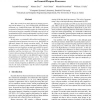IEEEPACT
2007
IEEE
14 years 6 months ago
2007
IEEE
Under current worst-case design practices, manufacturers specify conservative values for processor frequencies in order to guarantee correctness. To recover some of the lost perfo...
IEEEPACT
2007
IEEE
14 years 6 months ago
2007
IEEE
There has recently been much interest in stream processing, both in industry (e.g., Cell, NVIDIA G80, ATI R580) and academia (e.g., Stanford Merrimac, MIT RAW), with stream progra...
IEEEPACT
2007
IEEE
14 years 6 months ago
2007
IEEE
Transactional Memory (TM) simplifies parallel programming by supporting atomic and isolated execution of user-identified tasks. To date, TM programming has required the use of l...
IEEEPACT
2007
IEEE
14 years 6 months ago
2007
IEEE
The allocation of lock objects to critical sections in concurrent programs affects both performance and correctness. Recent work explores automatic lock allocation, aiming primari...
IEEEPACT
2007
IEEE
14 years 6 months ago
2007
IEEE
The process of verifying a new microprocessor is a major problem for the computer industry. Currently, architects design processors to be fast, power-efficient, and reliable. Howe...
IEEEPACT
2007
IEEE
14 years 6 months ago
2007
IEEE
Performance auditing is an online optimization strategy that empirically measures the effectiveness of an optimization on a particular code region. It has the potential to greatly...
IEEEPACT
2007
IEEE
14 years 6 months ago
2007
IEEE
IEEEPACT
2007
IEEE
14 years 6 months ago
2007
IEEE
Loop nest optimization is a combinatorial problem. Due to the growing complexity of modern architectures, it involves two increasingly difficult tasks: (1) analyzing the profita...
IEEEPACT
2007
IEEE
14 years 6 months ago
2007
IEEE
Continued scaling of CMOS technology to smaller transistor sizes makes modern processors more susceptible to both transient and permanent hardware faults. Circuitlevel techniques ...
IEEEPACT
2007
IEEE
14 years 6 months ago
2007
IEEE
Many sorting algorithms have been studied in the past, but there are only a few algorithms that can effectively exploit both SIMD instructions and threadlevel parallelism. In this...



